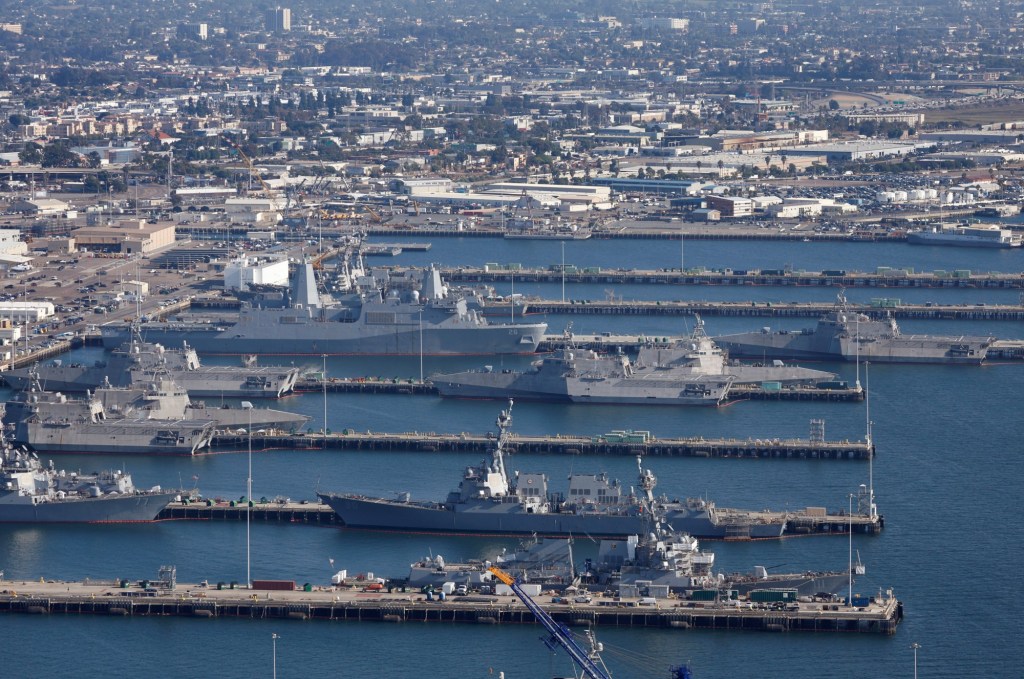In a contraption of his own making, Glenn Curtiss took to the skies in 1911, boldly becoming the first American to fly a seaplane in a quick trip from Coronado’s North Island to San Diego Bay.
The aviation pioneer was hoping the U.S. Navy would recognize the possible uses of such a machine, which it did weeks later upon hoisting the aircraft on and off a warship. It was the aha moment that ushered in the age of aircraft carriers.
The birth of naval aviation also led to a metamorphosis in San Diego, which will celebrate the 250th anniversary of the Navy on Monday and the same milestone for the Marines weeks later, on Nov. 10.
A city that had virtually no naval presence in the early 1900s became known as Navy Town, USA, in the 1930s and evolved into the largest Navy installation on the West Coast.
San Diego is one of the few places in the world that is home to three aircraft carriers. They share space with 55 other warships and four submarines. The city is also home to the 3rd Fleet, which patrols 50 million square miles of the Pacific.
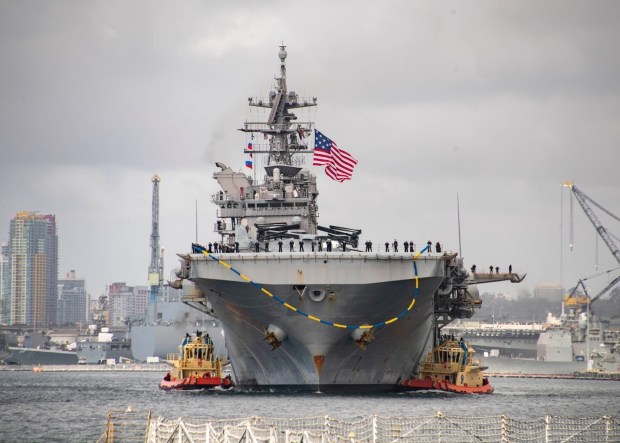 Amphibious assault ship USS Tripoli (LHA 7) transits San Diego Harbor as the ship returns to homeport, Nov. 29, 2022. (Mass communication Specialist 2nd Class Brett McMinoway / U.S. Navy)
Amphibious assault ship USS Tripoli (LHA 7) transits San Diego Harbor as the ship returns to homeport, Nov. 29, 2022. (Mass communication Specialist 2nd Class Brett McMinoway / U.S. Navy)
A massive defense industry emerged to support the Navy and Marines, producing everything from long-range bombers during World War II to Tomahawk cruise missiles during the Cold War to sophisticated drones today.
The value of this military-industrial partnership is enormous. It pumped $63 billion into the economy of San Diego County in fiscal 2024, supporting 111,000 active-duty service men and women, 6,000 military reservists and 30,000 civilians, according to the San Diego Military Advisory Council.
“I marvel at all that’s happened,” said Jim Kidrick, a retired Navy fighter pilot who patrolled the western Pacific and Middle East during the Cold War before becoming executive director of the San Diego Air and Space Museum in Balboa Park.
“Glenn Curtiss’ little plane changed the course of history,” he said, “shifting us away from battleships to aircraft carriers and leading us to other innovations that have made us a front line in the defense of the country.”
It also profoundly changed the makeup of San Diego County. Countless service members were seduced by the region’s beauty and fair weather and chose to settle here. Today, it’s home to an estimated 240,000 veterans.
“If you go out for a drive, go to the movies, go to a Padres game, you’ll be surrounded by active-duty service members and veterans,” said Phil Kendro of San Diego, a former Marine Corps fighter pilot who served in the wars in Iraq and Afghanistan.
“That’s what makes San Diego great.”
Timeline: Moments that shaped San Diego’s military history
1846: U.S. Marines and Navy sailors take possession of San Diego during the early months of the Mexican-American War. Two years later, the warring parties sign a treaty in which Mexico cedes huge amounts of land to the U.S., including all of present-day California.
1904: The Navy establishes its first permanent logistics station in San Diego, opening a fuel depot at the request of the city, which envisioned the military becoming an economic powerhouse. It is part of President Theodore Roosevelt’s larger plans to project U.S. military power in the Pacific.
1908: San Diego convinces the Navy to have its Great White Fleet, a group of 16 battleships, visit the city as it circumnavigates the globe. Huge crowds turn out, leading the Navy to look closer at San Diego and its protected harbor.
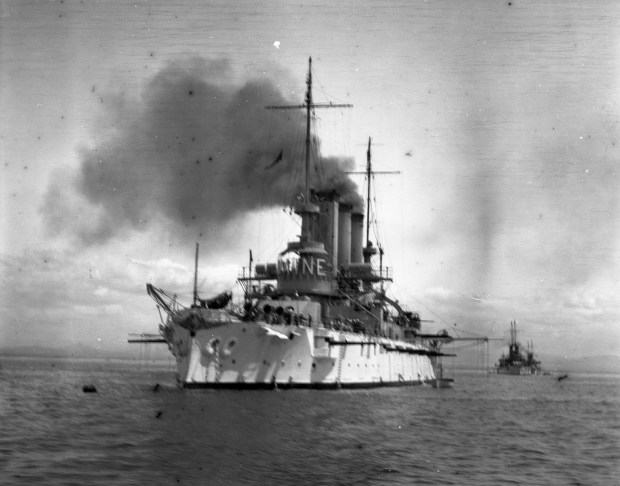 Battleship Maine of the Great White Fleet visiting San Diego in 1908. (San Diego History Center)
Battleship Maine of the Great White Fleet visiting San Diego in 1908. (San Diego History Center)
1910: San Diego gets a brief look at a new type of vessel — the submarine. The USS Grampus and USS Pike arrive for exercises and training with only a barge for support. Grampus makes headlines for traveling 8 miles underwater in San Diego Bay.
1911: Theodore Ellyson begins training to become the first Navy officer to qualify as an airplane pilot, studying under Glenn Curtiss on North Island. Ellyson is skeptical of the future, saying in 1912, “In my opinion, the aeroplane will be used by the Navy solely for scouting purposes, and not as an offensive weapon as seems to be the popular impression.”
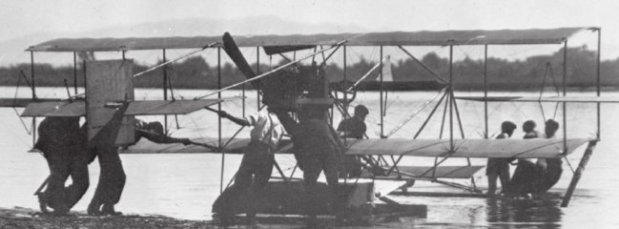 The Curtiss hydroaeroplane is guided into San Diego Bay on Jan. 26, 1911. (U.S. Navy)
The Curtiss hydroaeroplane is guided into San Diego Bay on Jan. 26, 1911. (U.S. Navy)
1914: The cruiser USS California is renamed USS San Diego, a publicity boon for the city. The cruiser is also designated as the flagship of the Pacific Fleet and spends a lot of time operating out of San Diego.
That same year, Marines move into Balboa Park, activating barracks. They become part of the Panama-California Exposition when it opens in 1915, putting on drills and parades that are popular with the public. During a visit, Franklin Roosevelt, assistant secretary of the Navy, says the city will become a supply and liberty port for the Navy.
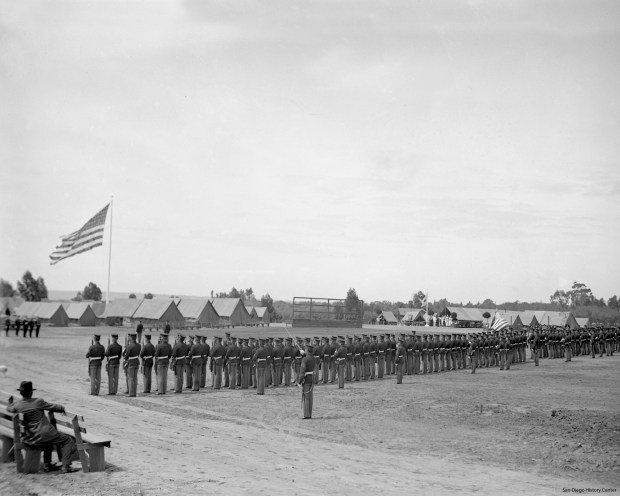 Marines at an encampment in Balboa Park in 1915 as part of the Panama-California Exposition. (San Diego History Center)
Marines at an encampment in Balboa Park in 1915 as part of the Panama-California Exposition. (San Diego History Center)
1917: The Navy creates an air station on North Island, the first permanent and significant military base of its kind in San Diego, during World War I, which had created a big need for pilots and mechanics. The site is today known as Naval Air Station North Island.
1919: President Woodrow Wilson begins transferring destroyers to San Diego and other western bases due to concerns about Japan’s expansionism in the Pacific.
1921: The first purpose-built Marine installation opens in San Diego to support an expeditionary force. It evolves into the Marine Corps Recruit Depot and has since graduated 1.5 million Marines, including 223,000 during World War II.
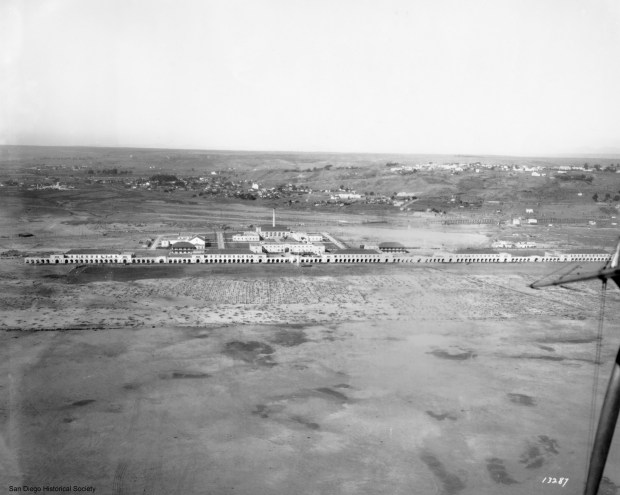 Aerial view of Marine Corps Base, San Diego, in the early 1920s, later renamed Marine Corps Recruit Depot. (San Diego History Center)
Aerial view of Marine Corps Base, San Diego, in the early 1920s, later renamed Marine Corps Recruit Depot. (San Diego History Center)
1922: The U.S. Destroyer Base opens near 32nd Street to repair destroyers active following World War I, as well as many that had been mothballed. The site is today known as Naval Base San Diego.
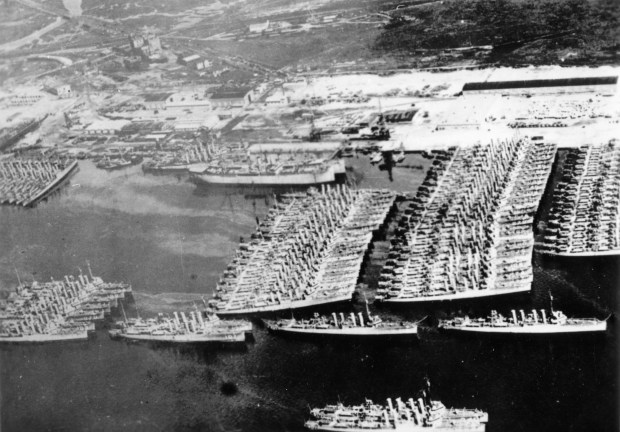 Aerial view of destroyers lined up at the U.S. Navy Destroyer Base at the foot of 32nd Street near San Diego Bay in 1928. (San Diego History Center)
Aerial view of destroyers lined up at the U.S. Navy Destroyer Base at the foot of 32nd Street near San Diego Bay in 1928. (San Diego History Center)
1924: The USS Langley, the Navy’s first aircraft carrier, begins operating out of San Diego. Over time, “flat tops” will overshadow battleships because of their ability to safely and more accurately strike targets at much greater distances. By 1935, the city is home to all four of the Navy’s carriers.
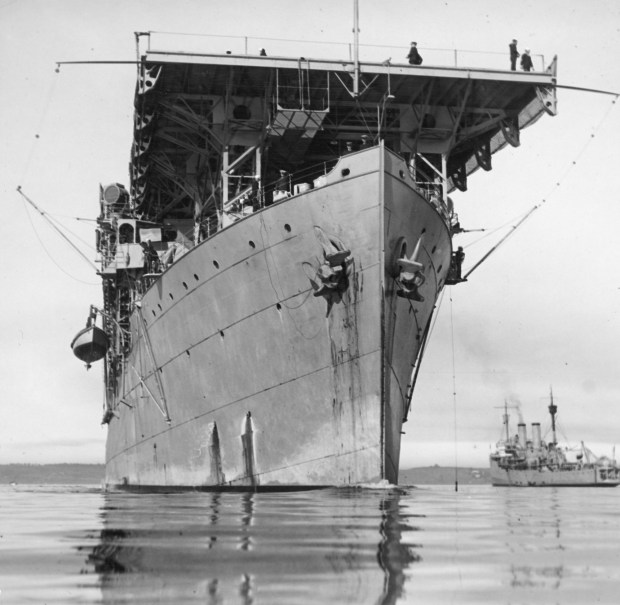 The USS Langley in 1924. (San Diego History Center)
The USS Langley in 1924. (San Diego History Center)
1935: Consolidated Aircraft moves to San Diego’s Lindbergh Field (now San Diego International Airport), revving up the defense industry as the U.S. moves toward World War II. It produces PBY Catalina “flying boats,” famous for air-sea rescue, and B-24 Liberators, a fabled bomber. North Island becomes the backdrop for Navy-sponsored movies that promote naval aviation.
Nearby, the Ryan Aeronautical Company builds trainer aircraft and the Ryan FR-1 Fireball, the first Navy aircraft with a jet engine.
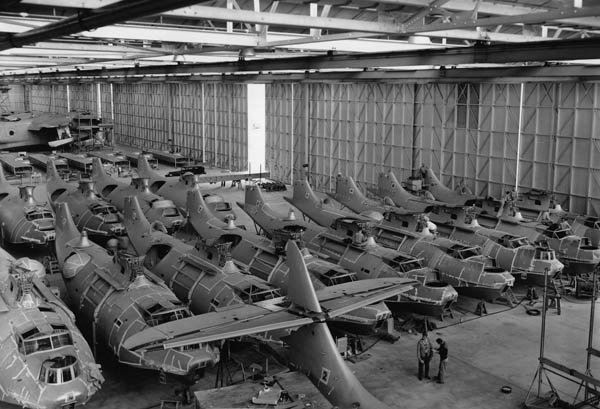 Consolidated Model 28, U.S. Navy PBY flying boats, in final assembly at the Consolidated Aircraft factory in San Diego in November 1940. (Consolidated Aircraft)
Consolidated Model 28, U.S. Navy PBY flying boats, in final assembly at the Consolidated Aircraft factory in San Diego in November 1940. (Consolidated Aircraft)
1941: The Japanese attack Pearl Harbor, triggering a huge military buildup. Land near Kearny Mesa is turned into a base that is today known as Marine Corps Air Station Miramar, and the Naval Amphibious Base opens in Coronado.
1942: Camp Pendleton opens north of Oceanside as a training and staging base. Members of the 1st Marine Division are among the first to deploy to the Pacific and play a pivotal role at the Battle of Guadalcanal, helping halt Japanese expansion.
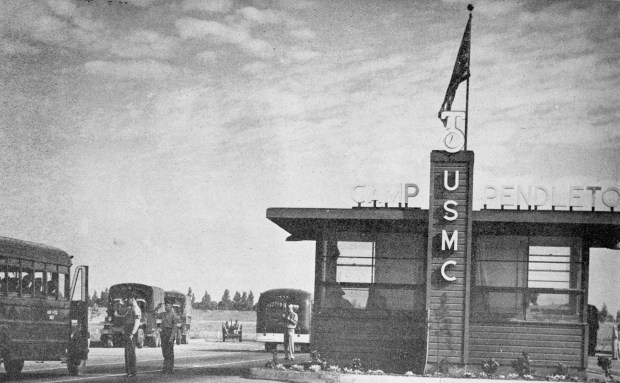 Entrance to Camp Pentleton in 1944. (San Diego History Center)
Entrance to Camp Pentleton in 1944. (San Diego History Center)
1950: Members of Pendleton’s 1st Marine Division lead an amphibious assault at Inchon, helping U.S. Gen. Douglas MacArthur turn the course of the Korean War in favor of allied forces. 1st Marine Division also ends up at the Battle of Chosin Reservoir, one of the most brutal fights in Marine history. It lasts 17 days, and temperatures fall as low as -36 degrees.
1962: President John F. Kennedy establishes SEAL Team One on Coronado to help pursue unconventional warfare. The small team, along with subsequent ones, proves highly effective. The Viet Cong nickname the SEALs the “men with green faces” because of the eerie face paint they wear.
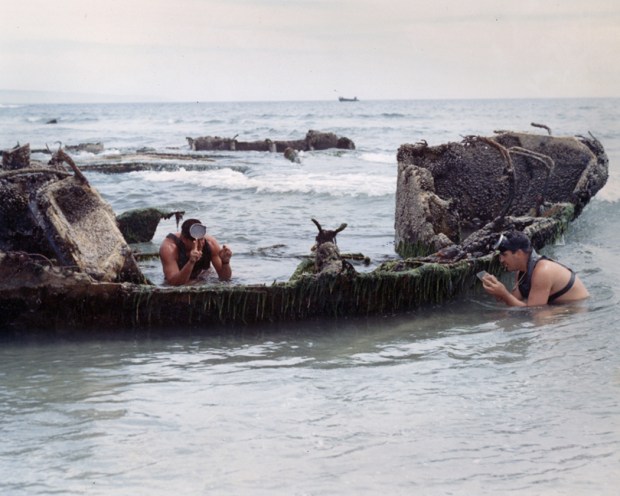 Two U.S. Navy SEALs conduct hydrographic readings near a shipwreck on Silver Strand Beach in the 1960s. The diver on the right is holding a slate and wax pencil to transcribe the readings from the SEAL on the left. (National Navy UDT-SEAL Museum)
Two U.S. Navy SEALs conduct hydrographic readings near a shipwreck on Silver Strand Beach in the 1960s. The diver on the right is holding a slate and wax pencil to transcribe the readings from the SEAL on the left. (National Navy UDT-SEAL Museum)
1969: The Navy Fighter Weapons School, better known as Top Gun, opens at MCAS Miramar. It was created to eliminate the outdated aerial combat tactics that led to high casualty rates and poor performances.
“They wanted me to put together a graduate school in tactics and gave me only 60 days to get it going,” Don Pedersen, the retired Navy captain who created Top Gun, recently told the Union-Tribune. “It happened that fast.”
The school becomes famous in 1986 with the release of the hit Tom Cruise movie “Top Gun,” leading the Navy to set up recruiting stations outside theaters. Top Gun was later moved to a base in Nevada.
1970: An effort by Coronado Navy wives to bring back their prisoner of war husbands from Vietnam is solidified with the creation of the National League of POW/MIA Families. The publicity campaign and lobbying effort brings international attention to the plight of the prisoners.
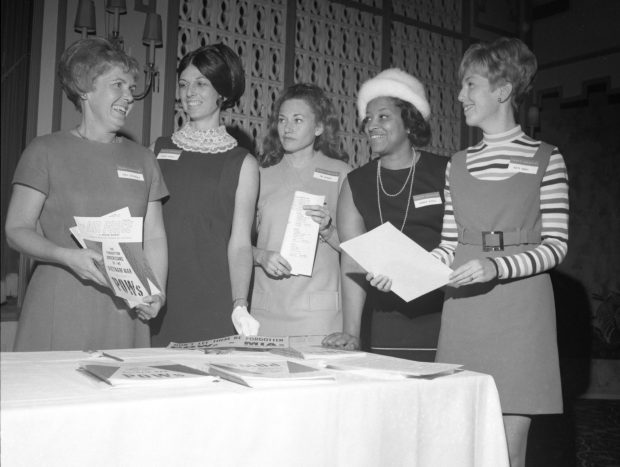 Sybil Stockdale, founder of the National League of POW Families, along with other POW wives, Mrs. Steven Hanson, Mrs. Arthur Mearns, Mrs. Roosevelt Hestle and Mrs. John Hardy, hold a news conference at a meeting of the Navy League on Feb. 27, 1970. (San Diego Union Tribune / San Diego History Center)
Sybil Stockdale, founder of the National League of POW Families, along with other POW wives, Mrs. Steven Hanson, Mrs. Arthur Mearns, Mrs. Roosevelt Hestle and Mrs. John Hardy, hold a news conference at a meeting of the Navy League on Feb. 27, 1970. (San Diego Union Tribune / San Diego History Center)
1975: The San Diego amphibious assault ship USS Okinawa helps evacuate refugees from the U.S. Embassy during the fall of Saigon. The last American to leave the embassy was Camp Pendleton-trained Marine John Valdez.
“When we landed on the ships, they told us they renamed the city Ho Chi Minh City,” Valdez later told the Union-Tribune. “The city known as Saigon was wiped off the map. It was gone.”
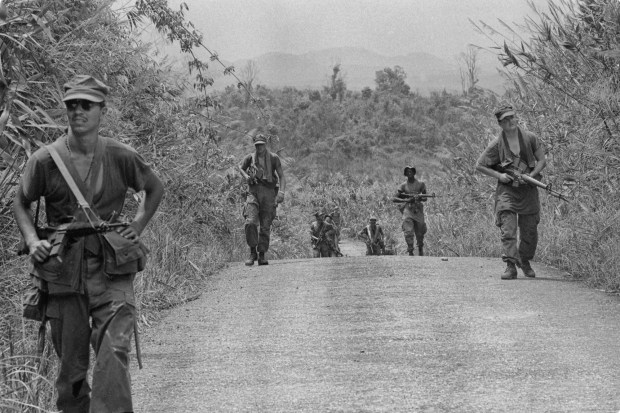 Marines of “Delta” Company, 1st Battalion, Fifth Marine Regiment, 1st Marine Division, sweep Route 545 and the mountain area near Nui Bong southeast of Phu Bai in Vietnam during a combat sweep on May 2, 1968. (Cpl. D. I. Fisher / National Archives)
Marines of “Delta” Company, 1st Battalion, Fifth Marine Regiment, 1st Marine Division, sweep Route 545 and the mountain area near Nui Bong southeast of Phu Bai in Vietnam during a combat sweep on May 2, 1968. (Cpl. D. I. Fisher / National Archives)
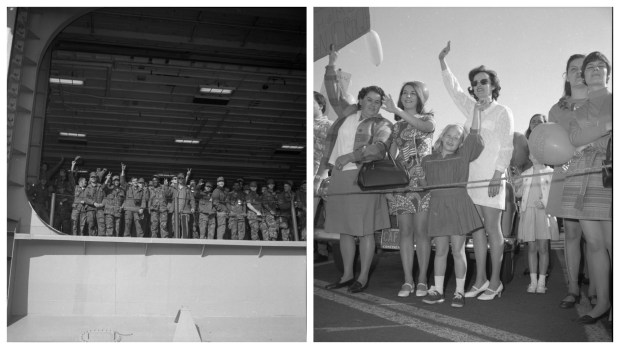 Marines wave as they return home to San Diego from Vietnam aboard the USS Tripoli. Paula Tidwell, 7, center in photo at right, daughter of Lt. Ed Tidwell, greets the Marines on the pier at Naval Air Station North Island. (The San Diego Union-Tribune / San Diego History Center)
Marines wave as they return home to San Diego from Vietnam aboard the USS Tripoli. Paula Tidwell, 7, center in photo at right, daughter of Lt. Ed Tidwell, greets the Marines on the pier at Naval Air Station North Island. (The San Diego Union-Tribune / San Diego History Center)
1975: More than 50,000 Vietnamese, Cambodian and Laotian refugees end up living in a temporary tent city at Camp Pendleton. Many of them settle in San Diego County.
1986: San Diego’s reputation for testing new technology gets a lift with the arrival of USS Bunker Hill, the first Ticonderoga-class cruiser built with the highly sophisticated Mk 41 VLS missile launch system.
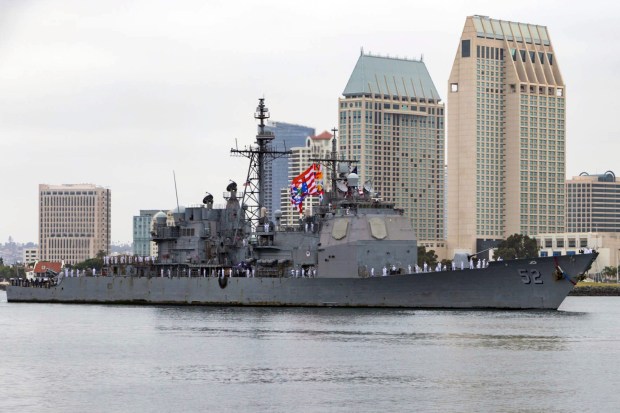 Sailors man the rails as the guided-missile cruiser USS Bunker Hill (CG 52) returns to Naval Base San Diego after a six-month deployment in support of maritime security operations and theater security cooperation efforts on July 8, 2020. (MC1 Woody Paschall / U.S. Navy)
Sailors man the rails as the guided-missile cruiser USS Bunker Hill (CG 52) returns to Naval Base San Diego after a six-month deployment in support of maritime security operations and theater security cooperation efforts on July 8, 2020. (MC1 Woody Paschall / U.S. Navy)
1991: Marines from Camp Pendleton help lead the ground assault that pushes Iraq out of Kuwait during Operation Desert Storm. The Iraqis are also pounded by air attacks from the San Diego carrier USS Ranger.
1993: President George H.W. Bush meets with Camp Pendleton Marines while they’re conducting a humanitarian mission in Somalia, the site of immense famine.
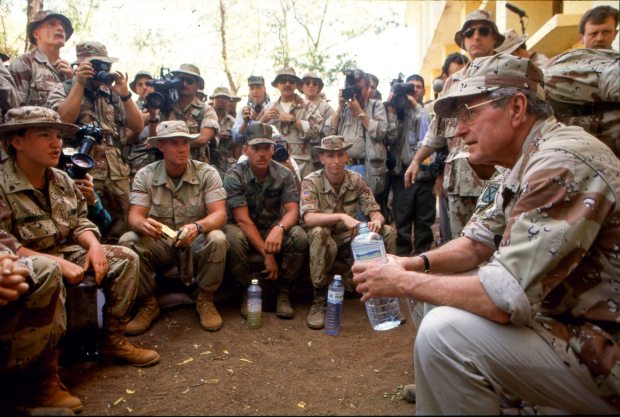 President George H.W. Bush meets with Marines in Somalia in 1993. (Hayne Palmour IV / The San Diego Union-Tribune)
President George H.W. Bush meets with Marines in Somalia in 1993. (Hayne Palmour IV / The San Diego Union-Tribune)
2001: A U.S.-led coalition invades Afghanistan in the wake of the Sept. 11, 2001, terrorist attack. Tens of thousands of Camp Pendleton Marines serve in the war, the longest in American history.
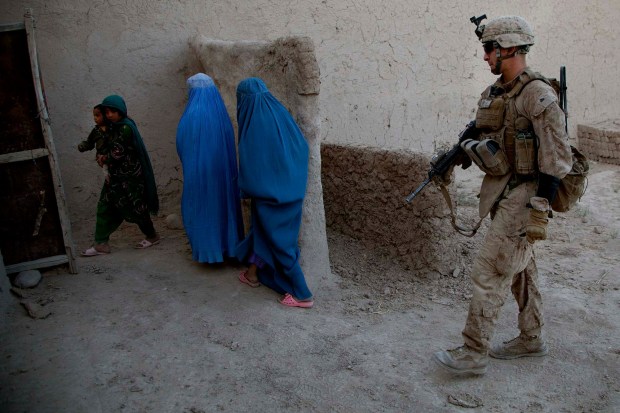 Cpl. Greg Dominguez, from Bonita, with 2/5, Fox Company conducting Operation Branding Iron in Lwar Bajigar, Afghanistan, escorts civilians away from the compound where his squad was to use as a defensive position on July 6, 2012. (Nelvin C. Cepeda / The San Diego Union-Tribune)
Cpl. Greg Dominguez, from Bonita, with 2/5, Fox Company conducting Operation Branding Iron in Lwar Bajigar, Afghanistan, escorts civilians away from the compound where his squad was to use as a defensive position on July 6, 2012. (Nelvin C. Cepeda / The San Diego Union-Tribune)
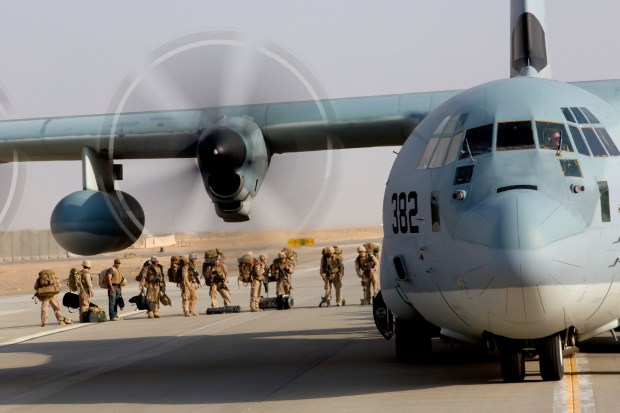 At Bastion Airfield in Helmand Province, Afghanistan, some of the last Marines left on Camp Leatherneck board a C-130 for the official withdrawal of U.S. Marines on Oct. 27, 2014. (Nelvin C. Cepeda / The San Diego Union-Tribune)
At Bastion Airfield in Helmand Province, Afghanistan, some of the last Marines left on Camp Leatherneck board a C-130 for the official withdrawal of U.S. Marines on Oct. 27, 2014. (Nelvin C. Cepeda / The San Diego Union-Tribune)
2003: San Diego County-based Marines are among the nation’s first fatalities in the invasion of Iraq. More deaths follow.
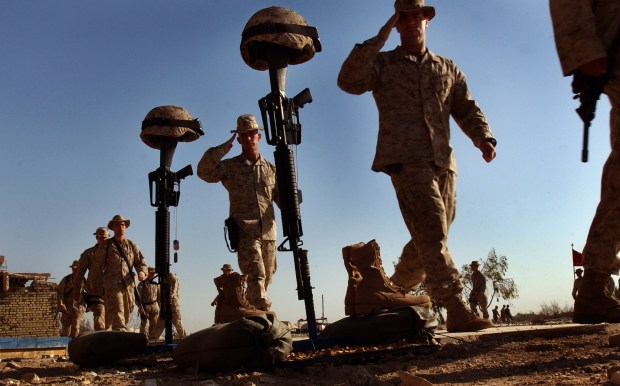 On the Fourth of July, 2004, Marines from the 2nd Battalion, 1st Marines Regiment at Camp Baharia walk past a memorial and render a salute honoring two Marines who died in Fullujah, Iraq. (Nelvin C. Cepeda / The San Diego Union-Tribune)
On the Fourth of July, 2004, Marines from the 2nd Battalion, 1st Marines Regiment at Camp Baharia walk past a memorial and render a salute honoring two Marines who died in Fullujah, Iraq. (Nelvin C. Cepeda / The San Diego Union-Tribune)
2004: The fabled aircraft carrier USS Midway becomes a permanent museum in San Diego, where it now attracts about 1 million visitors per year.
2010: Twenty-five Marines from Camp Pendleton’s 3rd Battalion, 5th Marine Regiment are killed and about 200 are wounded in Sangin, Afghanistan, the highest casualty rate of any Marine unit to date in the war in Afghanistan.
2011: The Obama administration announces the “Pacific Pivot,” an effort to place more ships on the West Coast due to rising tensions in the Asia-Pacific region. San Diego’s complement of ships is supposed to rise to 70 from about 54, but that largely doesn’t happen because the Navy is struggling to build new ships and maintain older ones.
Some of the new Independence-class littoral combat ships that later arrive in San Diego have design and performance problems, hampering the Navy’s ability to patrol near-shore coastal waters to deal with threats such as mines, small surface crafts and quiet submarines.
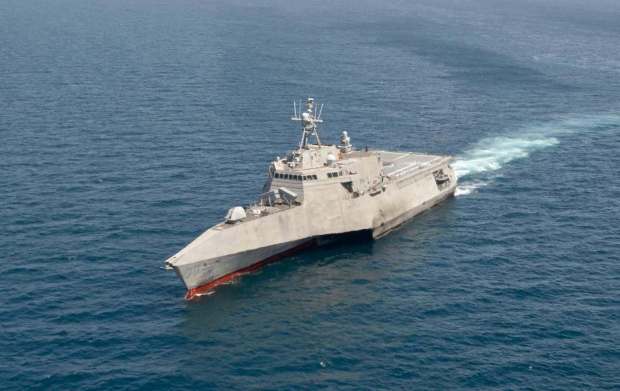 The San Diego-based littoral combat ship USS Canberra arrives in Bahrain to conduct mine-sweeping operations on the region in May 2025. (U.S. Central Command)
The San Diego-based littoral combat ship USS Canberra arrives in Bahrain to conduct mine-sweeping operations on the region in May 2025. (U.S. Central Command)
2013: Singapore-based Navy contractor Leonard Glenn Francis, known as “Fat Leonard,” is arrested in a downtown San Diego hotel on charges of orchestrating a massive bribery and fraud scheme reaching some of the highest ranks in the Navy. Some 1,000 Navy personnel are investigated, and prosecutors secure guilty pleas or jury convictions against more than 30 people.
2020: The USS Bonhomme Richard burns for five days in San Diego Bay and must be scrapped. The service’s investigation finds that numerous failures in training and conditions on board contributed to the disaster, including a lack of training, missing equipment from fire stations and an inoperable automated foam system.
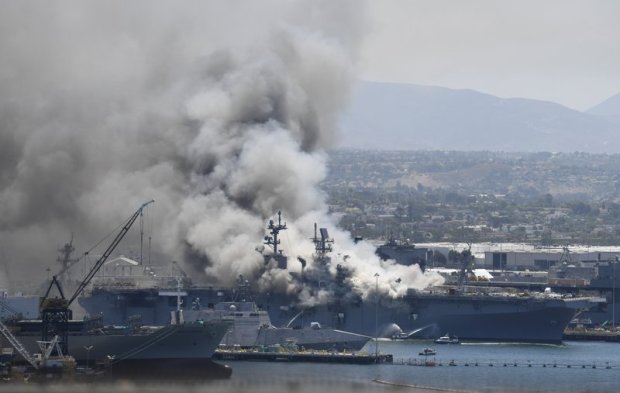 Smoke rises from the USS Bonhomme Richard at Naval Base San Diego July 12, 2020. (Denis Poroy / AP)
Smoke rises from the USS Bonhomme Richard at Naval Base San Diego July 12, 2020. (Denis Poroy / AP)
2021: Women Marines complete boot camp at Marine Corps Recruit Depot in San Diego for the first time.
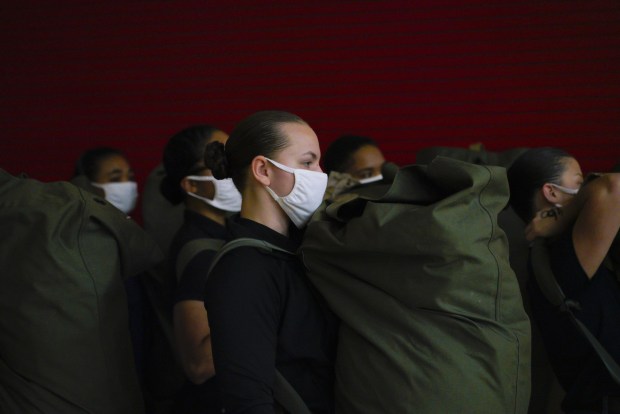 The first women recruits at Marine Corps Recruit Depot in San Diego on Feb. 9, 2021, carry their seabags awaiting their next orders during processing for their first day of boot camp. (Nelvin C. Cepeda / The San Diego Union-Tribune)
The first women recruits at Marine Corps Recruit Depot in San Diego on Feb. 9, 2021, carry their seabags awaiting their next orders during processing for their first day of boot camp. (Nelvin C. Cepeda / The San Diego Union-Tribune)
2024: San Diego aircraft carriers bomb weapons depots in Iran-backed Yemen to suppress Houthi rebel attacks on ships.
2024: A San Diego F-35B strike fighter lands on a Japanese aircraft carrier for the first time, proving that the two allies can jointly use one of the world’s most sophisticated jets.
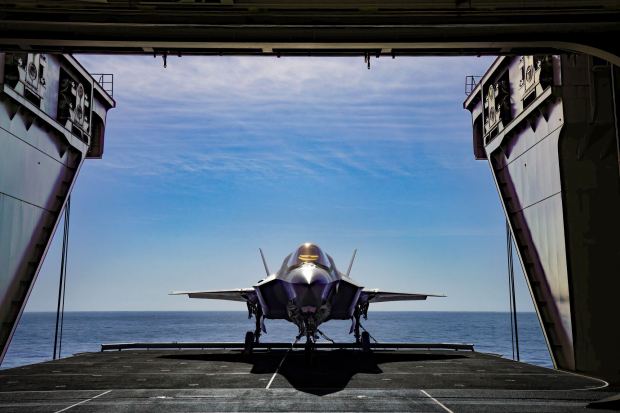 A U.S. Marine F-35B is lowered by the ship’s elevator into the hangar bay of Japan’s JS Kaga on Nov. 6, 2024. The Kaga is operating off the coast of San Diego. (Nelvin C. Cepeda / The San Diego Union-Tribune)
A U.S. Marine F-35B is lowered by the ship’s elevator into the hangar bay of Japan’s JS Kaga on Nov. 6, 2024. The Kaga is operating off the coast of San Diego. (Nelvin C. Cepeda / The San Diego Union-Tribune)
2025: The National Navy UDT-SEAL Museum opens near the Embarcadero in San Diego.
2026: If things go as planned, the amphibious warship USS Somerset will recover the four-person crew of NASA’s Artemis II mission in February when they splash down off San Diego after completing a flyby of the moon.
Sources: U.S. Navy, U.S. Marines, U.S. Naval Institute, San Diego History Center, San Diego Air and Space Museum, National Navy UDT-SEAL Museum, Maritime Museum of San Diego, Coronado Historical Association, Camp Pendleton Historical Society, USS Midway Museum, Smithsonian magazine, General Accountability Office, Congressional Research Service, National Archives and historian Bruce Linder.

